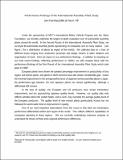Performance Findings of the International Assembly Plant Study
Author(s)
MacDuffie, John Paul; Pil, Frits K.
DownloadMac_Pil1.pdf (61.80Kb)
Metadata
Show full item recordAbstract
We recently undertook the largest in-depth evaluation ever of automobile assembly
plants around the world. In the Second Round of the International Assembly Plant Study, we
surveyed 88 automobile assembly plants representing 20 companies and as many nations (see figure 1 for a distribution of plants by region of the world). We collected data on a host of different issues ranging from production processes and design choices to labor relations and organization of work. Here we report on our performance findings. In addition to reporting on
our most recent findings, reflecting performance in 1993/4, we will compare those with the
performance findings of the First Round of the International Assembly Plant Study which took
place in 19892. European plants have shown the greatest percentage improvement in productivity of any region, but Korean plants, and plants in North America have also shown considerable gain. Given the minimal improvement in the average performance of Japanese-owned assembly plants in Japan, the performance gap between US and Japanese plants has closed significantly, although a differential still remains.
In the area of quality, the European and US producers have shown tremendous improvement, and are approaching Japanese quality levels. However, our quality data only reflects vehicles sold in the United States, and as such, may overstate the average quality level of the European producers. The quality level of new entrant plants (particularly Korea) has not
followed the world-wide trend in improvement in quality. One of our most important observations from this round is that there are tremendous
performance differentials within each region of the world. This reflects different capabilities of companies operating in those regions. We are currently undertaking extensive analyses to
understand the drivers of these intra-regional performance differences.
Date issued
2002-09-04Keywords
automobile assembly, International Assembly Plant Study